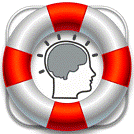Coping with chronic pain or chronic illness in recovery is important because it affects you in many ways. Physically, you are uncomfortable and may have a hard time sleeping. Emotionally you may feel depressed, hopeless and frustrated. Socially you may feel isolated and more impatient with other people. All of these things can make your mood worse and, lead to a relapse.
The first step in coping with chronic conditions is to receive a thorough medical evaluation to determine the cause of your symptoms and a medical treatment plan. When the pain is chronic and the health condition unchangeable, one goal can be to try and keep the chronic condition from being the entire focus of your life.
In the video I go over many techniques for dealing with the depression, anxiety, guilt and grief that may occur if you have a chronic health or mental health condition.
Regardless of the condition, there are a number of effective strategies for coping with chronic pain and stress. And, we know that stress makes most conditions worse, so…. These techniques generally include:
Relaxation training: Relaxation involves concentration and slow, deep breathing to release tension from muscles and relieve pain. Learning to relax takes practice, but relaxation training can focus attention away from pain and release tension from all muscles. Progressive Relaxation videos are widely available to help you learn these skills. Yoga can fall into this realm if that is something that interests you.
Biofeedback: Biofeedback uses special machines to help you learn to control bodily functions, such as heart rate and muscle tension. As you learn to reduce your heart rate, the machine immediately indicates success. Biofeedback can be used to reinforce relaxation training. Once the technique is mastered, it can be practiced without the use of the machine. I use a basic fitness monitor with a wrist-based heart rate sensor. We know that is pain or stress increase so does your heart rate and breathing. By slowing your breathing and trying to let tension go, you will lower your heart rate.
Visual imagery and distraction: Imagery involves concentrating on mental pictures of pleasant scenes or events or mentally repeating positive words or phrases to reduce pain or distress. Guided imagery videos are also available on Youtube. For guided imagery to be most effective, it is important to use all of your senses.
Distraction techniques: These techniques focus your attention away from negative or painful images or feelings to positive mental ones. This may include activities as simple as watching television or a favorite movie, reading a book or listening to a book on tape, listening to music, or talking to a friend.
Listed below are several imagery and chronic pain control techniques that have been found to be effective. Experiment with some of them the next time you have pain—chronic pain, or even just a headache or kink in your neck.
Activity: Pain Control Techniques
Altered focus
Focus your attention on any specific non-painful part of the body and imagine altering the sensation in that part of the body. For example, imagine your hand warming up. This will take the mind away from focusing on the source of your pain, such as your back pain. This can also be accomplished by having someone give you a massage. You will be so focused on the good feeling, that you will temporarily forget the pain.
If you don't want to imagine, you can actually alter the sensation by putting your hand in cold or warm water or running it gently over something bumpy or super soft (like your cat).
If you are experiencing emotional pain or distress, you can also choose to focus on something outside of yourself like a a picture or a cloud. I like focusing on a cloud and trying to continually identify new shapes it makes. It requires enough focus that it occupies my mind.
Mental anesthesia
This involves imagining putting a numbing anesthetic (like Novocain) onto the painful area. You can also imagine a soothing and cooling ice pack being placed onto the area of pain. Alternatively, you can imagine your brain producing massive amount of endorphins, the natural pain relieving substance of the body, and having them flow to the painful parts of your body. Visualize them going from your brain, down your neck and out to the painful part of your body.
The same sort of thing is true with emotions. You can visualize your brain sending your happiness or relaxation chemicals throughout your body. Or, imagine your unpleasant feelings in a paintball war with your happy feelings.
Symbolic imagery
Envision a symbol that represents your chronic pain or distress, such as a loud, irritating noise or a painfully bright light bulb. Gradually reduce the irritating qualities of this symbol, for example dim the light or reduce the volume of the noise, thereby reducing the pain.
Positive imagery
Focus your attention on a pleasant place that you could imagine going – the beach, mountains, etc. – where you feel carefree, safe and relaxed. For upper back tension you may imagine someone rubbing your back and taking the pain away. With practice, you will find that the relaxation and distress control effects become stronger and last longer after you are done.
NOTE: There are many more examples in the video.
